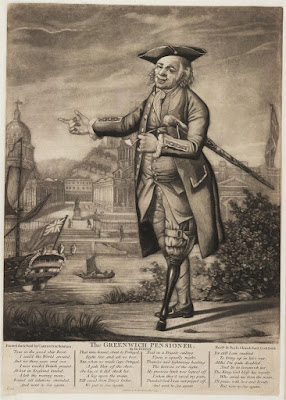 |
| The Last Jig or Adieu to Old England. Rowlandson, London, 1818. British Museum. |
Today's print is a Rowlandson caricature with plenty of great details! It shows one of the popular tropes for sailors in artwork: sailors kicking up bob's-a-dying one last time before their ship departs England. These sailors are on the berthdeck of their ship, with one sailor sitting on the breech of a gun and leaning on a barrel. One sailor plays a fiddle while a couple dances, and in the background more women, a punch bowl, and large jug all add to the merriment.
There are no fewer than seven sailors in this print. They all wear blue jackets with buttons colored the same blue as the coat, and white shirts. Most of them are wearing round hats, with the dancing sailor in the center showing a good example of the straight-sided flat-topped narrow-brimmed style, while the other sailors' hats lean more towards the caricaturist's stereotype of being drawn as misshapen and "squashy".

The fiddler wears blue and white striped trousers, shoes that might be tie shoes, a small black round hat perched at an angle on his head, and a single-breasted blue jacket worn open to show his white shirt with his mariner's cuffs worn closed. To the right of the fiddler in the back of the image on a barrel sits a sailor with a small round hat, a blue jacket with mariner's cuffs worn closed, and white or light blue trousers. The man on the floor to the right of the fiddler is mostly obscured, but we can see his blue jacket. He's also wearing a curious cap that looks decidedly like a thrum cap due to its shape and texture.

The dancing sailor in the center is curiously dressed for the date of this image: he's been drawn in breeches and slops, colored yellow and pink respectively. I had initially wondered if this image was a simple reprint of an earlier print, but the women's clothing and the shape of certainly fits for the 1810s. 1818 was a bit late for sailors to be wearing breeches, so there may be some degree of Rowlandson relying on a visual trope here: breeches and slops read "SAILOR" in 1818 in the same way that a dixie cup and crackerjack uniform reads sailor for us today. The sailor also wears buckled shoes, white stockings, a blue jacket with his cuffs worn open to show a white shirt underneath, and a red handkerchief tied around his neck with the knot at the collarbone. His hair is short and curly, and his round hat is straight-sided and flat-topped with a narrow brim.
A sailor in the background to the right of the dancer is obscured except for his blue jacket. Sitting on a barrel to the right of him is a sailor with a large punch bowl, wearing black shoes, white trousers, a blue jacket worn closed, a white handkerchief around his neck, and a round hat worn canted on his head. The last tar on the right is dressed exactly the same, though he's smoking a pipe and might be wearing a wig.
Other copies of this print offer different colorists' visions of the scene - or perhaps merely what was available in their watercolor boxes.
This print from the Royal Collection Trust shows some differences: three of the sailors have brown coats, the neck-cloths are two black and one yellow, the dancing sailor's breeches and slops are brown, the fiddler's trousers are blue instead of white and blue striped, and the man seated on the gun carriage has brown pants instead of white.
Yale University's Beinecke Rare Book and Manuscript Library's copy shows the same coloring scheme. There is
a copy of this print in the collection of The Walpole Library, but the plug-in to view it is currently not working for me.
This carefully-painted copy in the collection of Royal Museums Greenwich is remarkably different in its coloration - click on it to see it at the original size and enjoy the colorist's details. The dancing sailor wears horizontally-striped blue stockings, vertically striped blue slops, brown breeches, and a mottled red and orange handkerchief around his neck. What looked like a pocket flap in other versions of the print has been painted yellow, which makes its actual appearance as a tobacco case obvious. One sailor has a red and white striped handkerchief done in delicate brush-strokes, and another in mottled red and pink. All the sailors with shoes have their buckles painted gold, which makes it seem more like the fiddler has tie-shoes - the fiddler also has dark blue socks. Notably, all the sailors' small blue buttons are painted gold. Three of the sailors wear brown trousers and a fourth blue.
This print is an interesting case in how a caricaturist's literal broad brush can paint sailor's clothing in a different light than what might have been the reality: It's easy to leave white trousers the same white as the paper, which might make colored trousers underrepresented, and solid-colored handkerchiefs are easier to paint so they could be over-represented. Similarly, buttons are easy to paint over so they appear cloth covered, which means that one must be careful about making inferences about whether or not sailors wore brass buttons on their coats.

















































